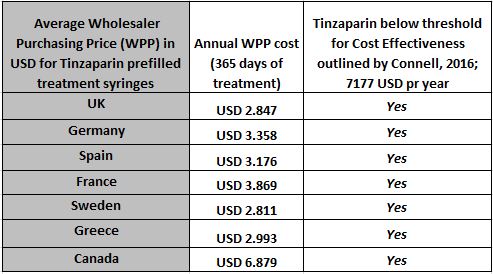
Contributions
Abstract: PB2128
Type: Publication Only
Background
New research has surfaced in relation to health care resource utilization and costs in Cancer Associated Thrombosis (CAT). The studies originate from the US and are difficult to transfer directly to other countries. A few studies in Europe focusing on the total cost of CAT seem to indicate that the cost data in the field of CAT varies greatly between regions. To examine the importance of region specific cost elements in relation to research related to CAT, we studied the cost driver in the newest and most relevant health economic research and compared it with the costs from 6 European countries as well as Canada.
Aims
To highlight the importance of localized or regionalized cost inputs as cost drivers when considering cost effectiveness in relation to CAT.
Methods
The cost driver is the medication in a recent analysis by Connell 2016 and thus the focus of our analysis. The American paper incorporates outcomes from 6 RCTs for treatment with LMWH in patients with CAT. The annual medication costs of LMWH for daily treatment in 365 days were 32,120 USD in wholesaler acquisition cost (WAC). For VKA the annual medication cost for 365 days was 44 USD. LMWH is the cost driver but is not cost effective due to the cost of it. The study finds that “ The one-way sensitivity analysis shows that LMWH would become the preferred strategy once its annual cost was less than $7177” . In the present analysis, the daily cost acquisition cost Wholesaler Purchasing Price (WPP) (which corresponds to the American WAC ) for a LMWH (prefilled treatment syringes with Tinzaparin) was gathered in 7 large markets using a data retrieval from IHS global insights systems (Jan 2016). In addition to this, the role of the cost driver was also compared to other publications.
Results
Simply by applying the local unit cost for the treatment with LMWH for these countries, the conclusion becomes notably different. LMWH becomes the cost effective alternative in the European countries as well as in Canada with annual costs below 7177 USD. The price for VKA is comparable to that in the US, and does not change the cost effectiveness ratio.

Conclusion
The exercise shows that using local input changes the conclusion and could potentially influence local evaluations related to the access for LMWH treatment for CAT. Tinzaparin was found to be a cost effective LMWH over VKA in 6 European Countries as well as in Canada, when local medication costs were used. This was in contrast to the conclusion in the US. Not using localized or regionalized cost inputs could potentially lead misinterpretations about cost effectiveness of CAT treatments.
Session topic: 35. Quality of life, palliative care, ethics and health economics
Keyword(s): Cancer, Thrombosis, Low molecular weight heparin, Cost effectiveness
Abstract: PB2128
Type: Publication Only
Background
New research has surfaced in relation to health care resource utilization and costs in Cancer Associated Thrombosis (CAT). The studies originate from the US and are difficult to transfer directly to other countries. A few studies in Europe focusing on the total cost of CAT seem to indicate that the cost data in the field of CAT varies greatly between regions. To examine the importance of region specific cost elements in relation to research related to CAT, we studied the cost driver in the newest and most relevant health economic research and compared it with the costs from 6 European countries as well as Canada.
Aims
To highlight the importance of localized or regionalized cost inputs as cost drivers when considering cost effectiveness in relation to CAT.
Methods
The cost driver is the medication in a recent analysis by Connell 2016 and thus the focus of our analysis. The American paper incorporates outcomes from 6 RCTs for treatment with LMWH in patients with CAT. The annual medication costs of LMWH for daily treatment in 365 days were 32,120 USD in wholesaler acquisition cost (WAC). For VKA the annual medication cost for 365 days was 44 USD. LMWH is the cost driver but is not cost effective due to the cost of it. The study finds that “ The one-way sensitivity analysis shows that LMWH would become the preferred strategy once its annual cost was less than $7177” . In the present analysis, the daily cost acquisition cost Wholesaler Purchasing Price (WPP) (which corresponds to the American WAC ) for a LMWH (prefilled treatment syringes with Tinzaparin) was gathered in 7 large markets using a data retrieval from IHS global insights systems (Jan 2016). In addition to this, the role of the cost driver was also compared to other publications.
Results
Simply by applying the local unit cost for the treatment with LMWH for these countries, the conclusion becomes notably different. LMWH becomes the cost effective alternative in the European countries as well as in Canada with annual costs below 7177 USD. The price for VKA is comparable to that in the US, and does not change the cost effectiveness ratio.

Conclusion
The exercise shows that using local input changes the conclusion and could potentially influence local evaluations related to the access for LMWH treatment for CAT. Tinzaparin was found to be a cost effective LMWH over VKA in 6 European Countries as well as in Canada, when local medication costs were used. This was in contrast to the conclusion in the US. Not using localized or regionalized cost inputs could potentially lead misinterpretations about cost effectiveness of CAT treatments.
Session topic: 35. Quality of life, palliative care, ethics and health economics
Keyword(s): Cancer, Thrombosis, Low molecular weight heparin, Cost effectiveness


